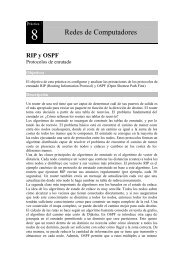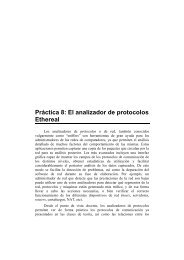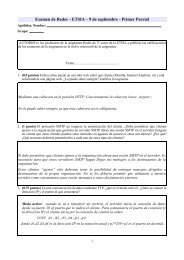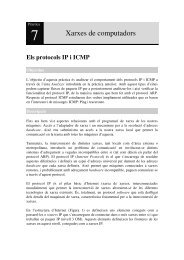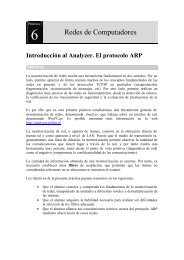Fourier Analysis - Redes de Computadores - UPV
Fourier Analysis - Redes de Computadores - UPV
Fourier Analysis - Redes de Computadores - UPV
You also want an ePaper? Increase the reach of your titles
YUMPU automatically turns print PDFs into web optimized ePapers that Google loves.
With –o option we specify the name of the resulting binary file. The –lm option is<br />
necessary to link with math library (sin and cos trigonometric functions)<br />
Impact of physical medium on the transmitted signal.<br />
Here we are going to use our program to analyze how the transmitted signal is distorted<br />
when crossing an specific transmission channel. For that purpose, we are going to<br />
produce four different scenarios corresponding with the transmission of one signal with<br />
the same transmission speed un<strong>de</strong>r different channel bandwidths. In particular, we will<br />
use channels with bandwidths of 400, 1000, 2000 and 9000 Hz.<br />
Run the program with the following parameters:<br />
./Mi<strong>Fourier</strong> –c a –v 1200 –b 400 –a 10000 > bw400.txt<br />
Option –c specifies the character we are going to transmit (also we can specify the<br />
ASCII co<strong>de</strong>: –c 97). Option –v fixes the transmission speed (in bits per second). With<br />
option --b we can <strong>de</strong>fine the <strong>de</strong>sired channel bandwidth. Finally, option –a is aesthetic<br />
option used to <strong>de</strong>termine width of the frequency domain plot (in Hz).<br />
As the character and transmission speed are just the same than the <strong>de</strong>fault ones, we do<br />
not need to specify them. Run the program to get results for the rest of proposed<br />
bandwidths.<br />
./Mi<strong>Fourier</strong> –b 1000 –a 10000 > bw1000.txt<br />
./Mi<strong>Fourier</strong> –b 2000 –a 10000 > bw2000.txt<br />
./Mi<strong>Fourier</strong> –b 9000 –a 10000 > bw9000.txt<br />
Compare the four graphics, using the GNUPlot program. You can observe that as<br />
bandwidth increases, more harmonics cross the channel and as a consequence the<br />
reconstructed signal is better (closer to the original one). Do you think that a bandwidth<br />
of 400 Hz is enough for transmitting this character with a speed of 1.200 bps. ? Should<br />
it be necessary a channel bandwidth of 9 KHz or it would be enough with 2 KHz?<br />
Impact of transmission speed on the transmitted signal<br />
En general, todos tenemos la i<strong>de</strong>a <strong>de</strong> que al transmitir por un medio físico una señal<br />
digital, la velocidad máxima <strong>de</strong> transmisión está acotada. Hay muchos factores que<br />
introducen esta limitación, pero uno <strong>de</strong> los principales es que el ancho <strong>de</strong> banda <strong>de</strong>l<br />
medio es limitado. Como ya hemos visto, esto provoca que a partir <strong>de</strong> una <strong>de</strong>terminada<br />
frecuencia, el resto <strong>de</strong> armónicos se atenúan.<br />
We can notice that transmission speed is very related with signal period T. So that, as<br />
transmission speed increases the signal period becomes shorter. The fundamental<br />
frequency that <strong>de</strong>termines the distance between harmonics also increases, so a lower<br />
number of harmonics will cross the channel and, as a consequence, the reconstructed<br />
signal will be poorer .<br />
8



